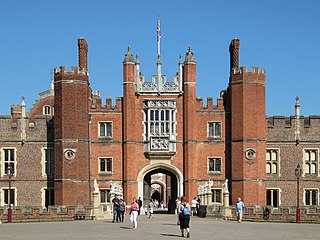
Hampton Court Palace is a Grade I listed royal palace in the London Borough of Richmond upon Thames, 12 miles southwest and upstream of central London on the River Thames. Opened to the public, the palace is managed by Historic Royal Palaces, a charity set up to preserve several unoccupied royal properties.
The Infantry of the British Army comprises 49 infantry battalions, from 19 regiments. Of these, 33 battalions are part of the Regular army and the remaining 16 a part of the Army Reserve. The British Army's Infantry takes on a variety of roles, including armoured, mechanised, air assault and light.

Richard III is a play by William Shakespeare. It was probably written c. 1592–1594. It is labelled a history in the First Folio, and is usually considered one, but it is sometimes called a tragedy, as in the quarto edition. Richard III concludes Shakespeare's first tetralogy and depicts the Machiavellian rise to power and subsequent short reign of King Richard III of England.

Richard III is a 1995 period drama film, based on William Shakespeare's play of the same name, directed by Richard Loncraine. The film adapts the play's story and characters to a setting based on 1930s Britain, with Richard depicted as a fascist plotting to usurp the throne.
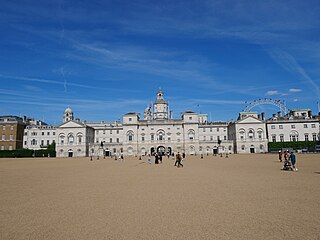
Horse Guards is a historic building in the City of Westminster, London, between Whitehall and Horse Guards Parade. It was built in the mid-18th century, replacing an earlier building, as a barracks and stables for the Household Cavalry. The current and previous buildings were, between the early 18th century and 1858, the main military headquarters for the British Empire. Horse Guards originally formed the entrance to the Palace of Whitehall and later St James's Palace; for that reason it is still ceremonially defended by the King's Life Guard.

Windsor & Eton Central station is one of two terminal stations serving the town of Windsor, Berkshire, England. Although a small part is still a railway station, most of the station building has been converted into a tourist-oriented shopping centre, called Windsor Royal Shopping. It is situated on Thames Street, almost immediately opposite Castle Hill, the main public entrance to Windsor Castle.
The Prince of Denmark's March, commonly called the Trumpet Voluntary, was written around 1700 by the English composer Jeremiah Clarke, the first organist of the then newly-rebuilt St Paul's Cathedral.
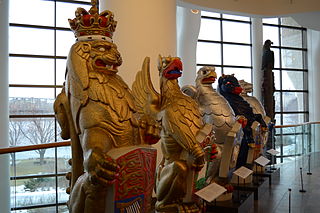
The Queen's Beasts are ten heraldic statues representing the genealogy of Queen Elizabeth II, depicted as the Royal supporters of England. They stood in front of the temporary western annexe to Westminster Abbey for the Queen's coronation in 1953. Each of the Queen's Beasts consists of a heraldic beast supporting a shield bearing a badge or arms of a family associated with the ancestry of Queen Elizabeth II. They were commissioned by the British Ministry of Works from the sculptor James Woodford, who was paid the sum of £2,750 for the work. They were uncoloured except for their shields at the coronation. They are now on display in the Canadian Museum of History in Gatineau, Quebec.
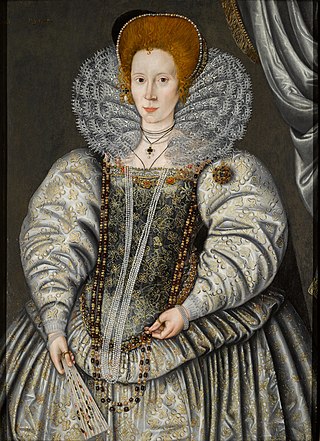
Elizabeth, Lady Raleigh, was an English courtier, a Gentlewoman of the Privy Chamber to Queen Elizabeth I of England. Her secret marriage to Sir Walter Raleigh precipitated a long period of royal disfavour for both her and her husband.
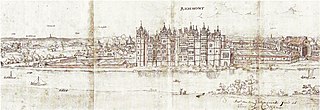
Richmond Palace was a royal residence on the River Thames in England which stood in the sixteenth and seventeenth centuries. Situated in what was then rural Surrey, it lay upstream and on the opposite bank from the Palace of Westminster, which was located nine miles (14 km) to the north-east. It was erected in about 1501 by Henry VII of England, formerly known as the Earl of Richmond, in honour of which the manor of Sheen had recently been renamed "Richmond". Richmond Palace therefore replaced Shene Palace, the latter palace being itself built on the site of an earlier manor house which had been appropriated by Edward I in 1299 and which was subsequently used by his next three direct descendants before it fell into disrepair.

Swindon Town Hall is a former municipal building in Swindon, England which was built in 1891 to be a centrepiece of New Swindon. It is currently used by Swindon Dance, a national dance agency. It is a Grade II listed building.

Thwaites & Reed has been in continuous manufacture since its foundation and claims to be the oldest clock manufacturing company in the world. Geoffrey Buggins MBE, the last of the original family clockmakers, saw drawings of Thwaites clocks dating back to 1610. These drawings and other early records prior to 1780 went missing but other records from that date are stored with the London Metropolitan Archives. Further records are stored by Thwaites & Reed up to present day.

Benjamin Lewis Vulliamy was a clockmaker, active in 18th and 19th century Britain. He succeeded his father Benjamin Vulliamy as head of the firm and Clockmaker to the Crown.

The Guildhall is a building on Alfred Gelder Street in the City of Kingston upon Hull, East Riding of Yorkshire, England. The building is currently the headquarters of Hull City Council but is also used as a venue for conferences, civic receptions and formal dinners. It is a Grade II* listed building status.

The Clock Tower is a free-standing clock tower in the centre of Brighton, part of the English city of Brighton and Hove. Built in 1888 in commemoration of the Golden Jubilee of Queen Victoria, the distinctive structure included innovative structural features and became a landmark in the popular and fashionable seaside resort. The city's residents "retain a nostalgic affection" for it, even though opinion is sharply divided as to the tower's architectural merit. English Heritage has listed the clock tower at Grade II for its architectural and historical importance.
Simon Michael Abney-Hastings, 15th Earl of Loudoun, styled as Lord Mauchline until 2012, is a British aristocrat living in Australia who is the current holder of the ancient Scottish noble title of Earl of Loudoun.

St Luke's Anglican Church is a heritage-listed Anglican church at Elizabeth Drive, Liverpool, Sydney, New South Wales, Australia. It was designed by Francis Greenway and built from 1818 to 1820. The property is owned by the Anglican Parish of Liverpool and is the oldest still existing Anglican church in Australia. It was added to the New South Wales State Heritage Register on 2 April 1999.

Stockton-on-Tees Town Hall is a municipal building in the High Street in Stockton-on-Tees, County Durham, England. The building, which is the meeting place of Stockton-on-Tees Borough Council, is a Grade II* listed building.
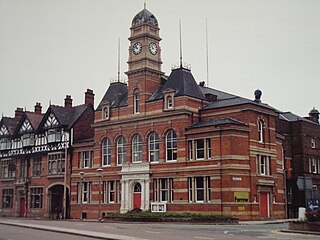
Eccles Town Hall is a municipal building in Church Street, Eccles, Greater Manchester, England. The town hall was the headquarters of Eccles Borough Council until the council was abolished in 1974.
















